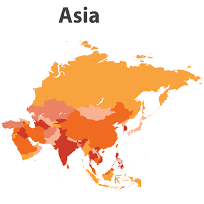AstraZeneca plc (LON:AZN) Forxiga (dapagliflozin) has been approved in the European Union (EU) for the treatment of symptomatic chronic heart failure with reduced ejection fraction (HFrEF) in adults with and without type-2 diabetes (T2D).
Heart failure (HF) is a life-threatening chronic disease that prevents the heart from pumping sufficient levels of blood around the body. It affects 15 million people in the EU, at least half of whom have a reduced ejection fraction,1-3 which occurs when the left ventricle muscle is not able to contract adequately and therefore expels less oxygen-rich blood into the body.4-6
The approval by the European Commission is based on positive results from the landmark DAPA-HF Phase III trial, published in The New England Journal of Medicine.7 It follows the recommendation for approval by the Committee for Medicinal Products for Human Use of the European Medicines Agency.
John McMurray, MD, Cardiovascular Research Centre, Institute of Cardiovascular and Medical Sciences, University of Glasgow, UK, said: “Today’s approval provides physicians with a completely novel treatment for heart failure with reduced ejection fraction, not only improving symptoms and reducing hospital admissions, but also increasing survival in this life-threatening condition.”
Mene Pangalos, Executive Vice President, BioPharmaceuticals R&D, said: “With this approval of Forxiga, we can redefine the standard of care for millions of people in the EU living with heart failure. We are another step closer to achieving our ambition of preventing or treating heart failure by providing a treatment that can significantly reduce cardiovascular death and hospitalisation.”
Forxiga is the first sodium-glucose co-transporter-2 (SGLT2) inhibitor to have shown a statistically significant reduction in the risk of the composite of cardiovascular (CV) death or worsening of HF events, including hospitalisation for HF (hHF). The DAPA-HF Phase III trial demonstrated that Forxiga, in addition to standard of care, reduced the risk of the composite outcome versus placebo by 26% and both components of the primary composite endpoint contributed benefit to the overall effect. In the DAPA-HF Phase III trial, the safety profile of Forxiga was consistent with the well-established safety profile of the medicine. During the trial, one CV death or hHF or an urgent visit associated with HF could be avoided for every 21 patients treated.
Forxiga (known as Farxiga in the US) is approved in the US for the treatment of patients with HFrEF and is currently under review in Japan and in several over countries around the world.
Forxiga is advancing cardiorenal prevention as science continues to identify the underlying links between the heart, kidneys and pancreas. DAPA-HF is part of DapaCare, a robust clinical trial programme to assess the potential CV and renal benefits of Forxiga. The programme has also explored the treatment of patients with chronic kidney disease (CKD) in the ground-breaking DAPA-CKD Phase III trial. Additionally, Forxiga is currently being tested for HF patients with preserved ejection fraction (HFpEF) in the DELIVER Phase III trial with data anticipated in the second half of 2021.
Heart failure
HF affects approximately 64 million people worldwide (at least half of whom have a reduced ejection fraction), including 15 million in the EU and six million in the US.2-3,8 It is a chronic disease where half of patients will die within five years of diagnosis.9 There are two main categories of HF related to ejection fraction (EF), a measurement of the percentage of blood leaving the heart each time it contracts: HFrEF and HFpEF.7 HFrEF occurs when the left ventricle muscle is not able to contract adequately and therefore, expels less oxygen-rich blood in to the body.5,6 HF remains as fatal as some of the most common cancers in both men (prostate and bladder cancers) and women (breast cancer).10 It is the leading cause of hospitalisation for those over the age of 65 and represents a significant clinical and economic burden.11
DAPA-HF
DAPA-HF (Dapagliflozin And Prevention of Adverse-outcomes in Heart Failure) is an international, multi-centre, parallel-group, randomised, double-blinded Phase III trial in 4,744 patients with heart failure and reduced ejection fraction (LVEF ≤ 40%), with and without T2D, designed to evaluate the effect of Forxiga 10mg, compared with placebo, given once daily in addition to standard of care. The primary composite endpoint was time to the first occurrence of a worsening heart failure event (hospitalisation or equivalent event; i.e. an urgent heart failure visit), or cardiovascular death. The median duration of follow-up was 18.2 months.
Forxiga
Forxiga (dapagliflozin) is a first-in-class, oral, once-daily SGLT2 inhibitor indicated in adults for the treatment of insufficiently controlled T2D as both monotherapy and as part of combination therapy as an adjunct to diet and exercise to improve glycaemic control, with the additional benefits of weight loss and blood-pressure reduction.
Forxiga has been evaluated in patients with CKD in the Phase III DAPA-CKD trial, with the full results announced in August 2020 demonstrating that Forxiga met all primary and secondary endpoints, providing overwhelming efficacy. Forxiga is currently being tested for patients with HF in the DELIVER (HF with preserved ejection fraction, HFpEF) and DETERMINE (HFrEF and HFpEF) Phase III trials. Forxiga will also be tested in patients without T2D following an acute myocardial infarction (MI) or heart attack in the DAPA-MI trial – a first of its kind, indication-seeking, registry-based randomised controlled trial. Forxiga has a robust programme of clinical trials that includes more than 35 completed and ongoing Phase IIb/III trials in more than 35,000 patients, as well as more than 2.5 million patient-years’ experience.
AstraZeneca in CVRM
Cardiovascular, Renal and Metabolism (CVRM) together forms one of AstraZeneca’s three therapy areas and is a key growth driver for the Company. By following the science to understand more clearly the underlying links between the heart, kidneys and pancreas, AstraZeneca is investing in a portfolio of medicines to protect organs and improve outcomes by slowing disease progression, reducing risks and tackling comorbidities. The Company’s ambition is to modify or halt the natural course of CVRM diseases and potentially regenerate organs and restore function, by continuing to deliver transformative science that improves treatment practices and cardiovascular health for millions of patients worldwide.












































